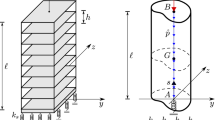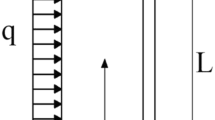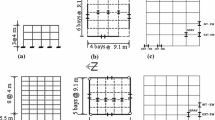Abstract
Purpose
The global buckling critical load ratio is a paramount parameter dictating the overall performance of tall buildings, yet its exploration has been notably lacking in the existing literature. This study addresses this gap by delivering a comprehensive theoretical investigation, along with presenting both analytical and numerical methods for computing the global buckling critical load ratio.
Methodology
These methods are designed to accommodate uniform and non-uniform tall buildings, taking into account diverse vertical load profiles, including considerations for soil flexibility. In this endeavor, a continuous Timoshenko-type model is employed, characterized by flexural and shear stiffness parameters defined by a dimensionless factor. To enhance the versatility of the analysis, an analytical solution method has been devised for uniform tall buildings. In contrast, a numerical solution method has been formulated to address the intricacies posed by tall structures exhibiting variable properties along their height, including soil flexibility.
Results and Conclusions
Notably, our investigation uncovers that the rotational flexibility of the underlying soil significantly influences the eigenvalues. Furthermore, the parametric analyses carried out in this study underscore the exceptional convergence achieved by the proposed solution methods and highlight the superiority of the continuous model, enabling the execution of parametric studies with minimal computational expenses.
















Similar content being viewed by others
References
Chitty L (1947) On the cantilever composed of a number of parallel beams interconnected by cross bars. The London, Edinburgh, Dublin Philos Mag J Sci 38:685–699. https://doi.org/10.1080/14786444708521646
Chitty L, Wan WY (1948) Tall building structures under wind load. 7th International Congress for Applied Mechanics: 254–268
Hegedűs I, Kollár LP (1984) Buckling of sandwich columns with thick faces subjecting to axial loads of arbitrary distribution. Acta Polytech Hungarica 97:123–132
Miranda E (1999) Approximate lateral drift demands in multi-story buildings subjected to earthquakes. J Struct Eng 124(4):417–425. https://doi.org/10.1061/(ASCE)0733-9445(1999)125:4(417)
Potzta G, Kollár LP (2003) Analysis of building structures by replacement sandwich beams. Int J Solids Struct 40(3):535–553. https://doi.org/10.1016/S0020-7683(02)00622-4
Kaviani P, Rahgozar R, Saffari H (2008) Approximate analysis of tall buildings using sandwich beam models with variable cross-section. Struct Des Tall Special Build 17:401–418. https://doi.org/10.1002/tal.360
Bozdogan KB, Ozturk D (2010) An approximate method for lateral stability analysis of wall-frame buildings including shear deformations of walls. Sadhana 35(3):241–253. https://doi.org/10.1007/s12046-010-0008-y
Zalka KA (2002) Buckling analysis of buildings braced by frameworks, shear walls and cores. Struct Des Tall Special Build 11(3):197–219. https://doi.org/10.1002/tal.194
Zalka KA (2007) A simple method for the deflection analysis of tall wall-frame building structures under horizontal load. Struct Des Tall Special Build 18(3):291–311. https://doi.org/10.1002/tal.410
Zalka KA (2013) Maximum deflection of symmetric wall-frame buildings. Period Polytech Civil Eng 2(57):173–184. https://doi.org/10.3311/PPci.7172
Laier JE (2021) An improved continuous medium technique for three-dimensional analysis of tall building structures. Struct Eng Mech 80(1):73–81. https://doi.org/10.12989/sem.2021.80.1.073
Franco C, Chesnais C, Semblat JF, Giry C, Desprez C (2022) Finite element formulation of a homogenized beam for reticulated structure dynamics. Comput Struct 261–262:106729. https://doi.org/10.1016/j.compstruc.2021.106729
Pinto MC (2023) Closed-form and numerical solution of the static and dynamic analysis of coupled shear walls by the continuous method and the modified transfer matrix method. Struct Eng Mech 86(1):49–68. https://doi.org/10.12989/sem.2023.86.1.049
Pinto MC (2023) A general simplified method for static and free vibration analysis of coupled shear walls of a bay. Mech Based Design Struct Mach. https://doi.org/10.1080/15397734.2023.2265466
Pinto MC (2023) A novel generalized sandwich-type replacement beam for static analysis of tall buildings: Inclusion of local shear deformation of walls. Thin-Walled Struct 190:110967. https://doi.org/10.1016/j.tws.2023.110967
Pinto MC (2023) Generalized sandwich beam for global stability analysis of tall buildings with shear walls using a modified transfer matrix method. Int J Struct Stab Dyn 24(4):2450036. https://doi.org/10.1142/S0219455424500378
Williams HE (2008) An asymptotic solution of the governing equation for the natural frequencies of a cantilevered, coupled beam model. J Sound Vib 312(1–2):354–359. https://doi.org/10.1016/j.jsv.2007.10.048
Akgöz B, Civalek Ö (2014) A new trigonometric beam model for buckling of strain gradient microbeams. Int J Mech Sci 81:88–94. https://doi.org/10.1016/j.ijmecsci.2014.02.013
Armand M, Adali S (2018) Buckling of nonuniform and axially functionally graded nonlocal Timoshenko nanobeams on Winkler-Pasternak foundation. Compos Struct 206:95–103. https://doi.org/10.1016/j.compstruct.2018.07.046
Uribe A, Zapata D, Arboleda L, Aristizabal J (2018) Static and dynamic stability of a multi-stepped Timoshenko column including self-weight. Structures 15:28–42. https://doi.org/10.1016/j.istruc.2018.05.004
Doeva O, Khaneh Masjedi P, Weaver PM (2020) Static deflection of fully coupled composite Timoshenko beams: an exact analytical solution. Eur J Mech - A/Solids 81:103975. https://doi.org/10.1016/j.euromechsol.2020.103975
Hamed MA, Abo-bakr RM, Mohamed SA, Eltaher MA (2020) Influence of axial load function and optimization on static stability of sandwich functionally graded beams with porous core. Eng Comput 36:1929–1946. https://doi.org/10.1007/s00366-020-01023-w
Hariz M, Le Marrec L, Lerbet J (2022) Buckling of Timoshenko beam under two-parameter elastic foundations. Int J Solids Struct 244–245:111583. https://doi.org/10.1016/j.ijsolstr.2022.111583
Ren Y, Huo R, Zhou D (2023) Buckling analysis of non-uniform Timoshenko columns under localised fire. Structures 51:1245–1256. https://doi.org/10.1016/j.istruc.2023.03.092
Ruocco E, Reddy JN (2023) Analytical solutions of Reddy, Timoshenko and Bernoulli beam models: a comparative analysis. Eur J Mech 99:104953. https://doi.org/10.1016/j.euromechsol.2023.104953
Cheng MH, Heaton TH (2015) Simulating building motions using ratios of the building’s natural frequencies and a Timoshenko Beam model. Earthq Spectra 31(1):403–420. https://doi.org/10.1193/011613EQS003
Ferretti M, D’Annibale F, Luongo A (2020) Buckling of tower buildings on elastic foundation under compressive tip forces and self-weight. Continuum Mech Thermodyn 35:799–819. https://doi.org/10.1007/s00161-020-00911-2
Rostami P, Mahsuli M, Ghahari SF, Taciroglu E (2021) Bayesian joint state-parameter-input estimation of flexible-base buildings from sparse measurements using Timoshenko Beam models. J Struct Eng 147(10). https://doi.org/10.1061/(ASCE)ST.1943-541X.0003095
Shirzad N, Mahsuli M, Ghahari SF (2018) Bayesian identification of soil-foundation stiffness of building structures. Struct Control Health Monit 25(3):e2090. https://doi.org/10.1002/stc.2090
Taciroglua E, Ghahari SF, Abazarsa F (2017) Efficient model updating of a multi-story frame and its foundation stiffness from earthquake records using a timoshenko beam model. Soil Dyn Earthq Eng 92:25–35. https://doi.org/10.1016/j.soildyn.2016.09.041
Terzi VG (2021) Soil-structure-interaction effects on the flexural vibrations of a cantilever beam. Appl Math Model 97:138–181. https://doi.org/10.1016/j.apm.2021.03.045
Abramowitz M, Stegun IA (1965) Handbook of mathematical functions. Dover Publications, New York
Cowper GR (1966) The Shear coefficient in Timoshenko’s beam theory. J Appl Mech 33:335–340. https://doi.org/10.1115/1.3625046
Huergo IF, Hernandez H, Patlán C (2020) A continuous-discrete approach for pre-design of flexible-base tall buildings with fluid viscous dampers. Soil Dyn Earthq Eng 131:106042. https://doi.org/10.1016/j.soildyn.2020.106042
Acknowledgements
The research described in this document was possible thanks to the support of Jesus Christ. The author dedicates this research to his mother, Lucía Cruz Trujillo, for being an example of overcoming challenges, perseverance, and the pillar of his life (I love you infinitely). The author acknowledges the support from the Multiphysics Modeling and Simulation Group at Instituto Tecgraf PUCRio.
Author information
Authors and Affiliations
Contributions
Mao Cristian Pinto-Cruz: Conceptualization, Methodology, Validation, Writing—original draft, Writing—review & editing, Software, Data curation, Validation.
Corresponding author
Ethics declarations
Conflict of interest
The author declares that they have no known competing financial interests or personal relationships that could have appeared to influence the work reported in this paper.
Additional information
Publisher's Note
Springer Nature remains neutral with regard to jurisdictional claims in published maps and institutional affiliations.
Rights and permissions
Springer Nature or its licensor (e.g. a society or other partner) holds exclusive rights to this article under a publishing agreement with the author(s) or other rightsholder(s); author self-archiving of the accepted manuscript version of this article is solely governed by the terms of such publishing agreement and applicable law.
About this article
Cite this article
Pinto-Cruz, M.C. A Numerical and Closed-Form Analytical Solution of the Global Buckling Critical Load of Tall Buildings Including Soil Flexibility: Timoshenko Beam. J. Vib. Eng. Technol. (2024). https://doi.org/10.1007/s42417-024-01316-0
Received:
Revised:
Accepted:
Published:
DOI: https://doi.org/10.1007/s42417-024-01316-0




